
The Enigmatic Life and Misfortunes of A Poet: Edgar Allan Poe
In the event of American literature, few names echo as hauntingly as that of Edgar Allan Poe. A writer, poet, editor, and literary critic, Poe carved a niche unlike any other, becoming the father of the detective story, a pioneer of the science fiction genre, and an unrivaled master of the horrible story. His tales continue to stir readers’ imaginations and chill their spines, more than a century after his death. But behind the chilling prose and iconic poems lies a life marked by tragedy, struggle, and genius.
This is the story of Edgar Allan Poe, a man whose haunted soul gave birth to some of the most enduring works in American literary history.
Who Was Edgar Allan Poe?
Edgar Allan Poe was born on January 19, 1809, in Boston, Massachusetts, to actors David and Eliza Poe. Orphaned by the age of three, his father having abandoned the family and his mother dying of tuberculosis, Poe was taken in by John and Frances Allan of Richmond, Virginia. Though never formally adopted, he took the name “Allan” as his middle name, a moniker he would carry throughout his life, albeit not always proudly.
Poe’s relationship with his foster father, John Allan, was strained and fraught with conflict. While Allan provided Poe with a good education, including a brief stint at the University of Virginia, he refused to support Poe financially beyond a certain point, especially when Poe accumulated gambling debts. This turbulent relationship led Poe to drop out of college and later leave West Point, further fueling his descent into financial instability and personal despair.
Despite these hardships, Poe was a voracious reader and an incredibly gifted writer. By his early twenties, he had decided to pursue a full-time literary career, a bold and risky endeavor in 19th-century America, where few writers could make a living from their craft.
Why Is Edgar Allan Poe So Famous?
Poe’s fame rests on the foundation of three literary pillars: his innovation, his style, and his psychological insight.
Literary Innovation: Poe is widely credited with inventing the modern detective story. His tale The Murders in the Rue Morgue (1841) introduced C. Auguste Dupin, a character who used ratiocination, a form of logical reasoning, to solve mysteries. This story laid the groundwork for later fictional detectives, including Arthur Conan Doyle’s Sherlock Holmes.
Master of the Macabre: Poe’s legacy is also rooted in his ability to tap into the darker corners of the human psyche. He didn’t just tell ghost stories; he explored themes of madness, obsession, death, and the supernatural in ways that felt uncomfortably real. His poetic and prose style combined beautiful language with grim subject matter, giving his work a uniquely Gothic quality.
Poetry and Meter: Poe’s lyrical works, especially The Raven, are celebrated for their musicality, rhythm, and deep emotion. His poems often mourn lost love and question the nature of life and death, timeless themes delivered in unforgettable verse.
Moreover, Poe was a literary critic, often scathing, who helped shape the tastes of his time. He believed literature should aim for beauty and emotional resonance, not just moral instruction, a view that clashed with the dominant Puritan ethos of American letters.
What Is Edgar Allan Poe’s Most Famous Story?
Without a doubt, Poe’s most famous and enduring work is the poem The Raven, published in 1845. The haunting narrative tells the story of a grieving man visited by a mysterious talking raven, whose only utterance, “Nevermore”, becomes a refrain that plunges the narrator into despair and madness.
The poem’s themes of lost love, lingering grief, and mental disintegration resonated deeply with readers, and its atmospheric tone and hypnotic rhythm made it an instant classic. Poe became a household name almost overnight, though not a wealthy one.
Among his short stories, The Tell-Tale Heart, The Fall of the House of Usher, and The Cask of Amontillado remain widely read and frequently adapted in films, television, and theater. Each story is a masterclass in suspense, psychological insight, and horror.
What Was Edgar Allan Poe’s Personality?
Understanding Poe’s personality is like walking a tightrope between admiration and concern. By all accounts, he was a man of sharp intellect, deep sensitivity, and uncompromising artistic vision. He could be charming and charismatic, particularly in literary circles, yet he was also prone to mood swings, depression, and self-doubt.
Poe was described by some contemporaries as introspective and melancholic, often obsessed with the idea of death, not just physical demise, but the death of beauty, love, and the human spirit. His mind, it seems, was a dark corridor filled with flickering lights, brilliant, erratic, and often ominous.
His critics noted a tendency toward arrogance and conflict, particularly in his role as a literary critic. He often publicly lambasted other authors, which earned him as many enemies as admirers. Yet even his detractors acknowledged his extraordinary talent.
Poe’s relationship with alcohol was another deeply tragic aspect of his character. Though he did not drink continuously, his bouts of drinking were intense and destructive, likely exacerbating his professional failures and personal sorrows.
What Was Edgar Allan Poe’s Tragic Life?
If Poe’s stories seem obsessed with death, madness, and despair, it’s because his life was saturated with these themes.
After being orphaned as a toddler, Poe faced a lifetime of financial instability and emotional loss. His attempts to earn a living as a writer in a country that did not yet have a robust literary economy were met with constant disappointment. At one point, he was so impoverished he reportedly had to burn furniture to stay warm.
In 1836, Poe married his 13-year-old cousin, Virginia Clemm. While modern readers may find the age difference disturbing, there is evidence to suggest theirs was a loving, if troubled, relationship. Virginia became the muse for many of Poe’s most poignant works, including the poems Annabel Lee and Lenore.
However, Virginia’s health declined soon after their marriage, and she suffered from tuberculosis, a disease that had already claimed Poe’s mother and would ultimately claim Virginia as well. She died in 1847, and her death devastated Poe. He sank deeper into depression and began to spiral both emotionally and professionally.
Poe’s final years were marked by increasing instability. He moved from city to city, taking editorial jobs and continuing to publish, but never finding lasting security or happiness. In October 1849, he was found delirious on the streets of Baltimore under mysterious circumstances. He died a few days later, on October 7, at the age of 40. The cause of his death remains uncertain, with theories ranging from alcohol poisoning and rabies to political kidnapping and heart disease.
The Legacy That Endures
Despite the tragedy of his life, Edgar Allan Poe left behind a legacy that is astonishing in its depth and influence. He is now celebrated not only as a foundational American author but as a global icon of Gothic literature. His work has inspired generations of writers, from H.P. Lovecraft and Stephen King to modern creators in film, music, and pop culture.
Museums, festivals, and literary societies across the world honor his memory. His Baltimore home is a National Historic Landmark, and every year fans and scholars gather to commemorate his life and works.
Perhaps most telling of Poe’s enduring impact is this: despite his tragic death, Edgar Allan Poe lives on in the shadows of our imagination. He reminds us that beauty and darkness are not always opposites, that from the depths of human sorrow can come the most haunting art.
The Man Behind the Mystery
In reading Poe, one is never far from a sense of dread, but also never far from awe. He was a man who bore the weight of life’s darkest shadows and, rather than flee from them, turned them into stories that continue to unsettle and inspire.
Who was Edgar Allan Poe? He was a visionary and a victim, a romantic and a poet, a man who seemed to carry death in his heart but beauty in his pen. He was ahead of his time, misunderstood in his own era but lionized in ours.
If you ever find yourself drawn to a tale of horror, a whisper of the supernatural, or a rhyme that lingers in your bones, remember Poe. For he gave voice to the fears we dare not speak and found poetry in the silence of the grave.




